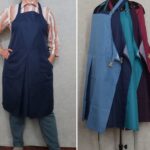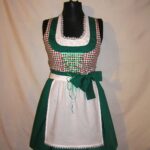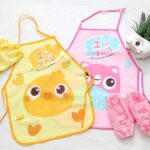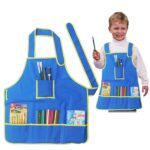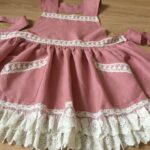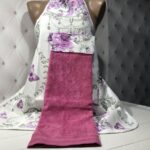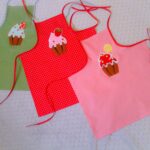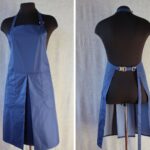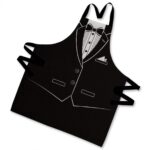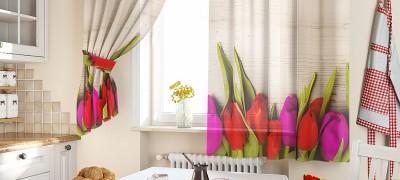How to sew an apron with your own hands
Traditionally, an apron is a kitchen accessory; you cannot imagine a hostess without this product while cooking. Today there are many models for different purposes. The article will cover the topic - how to sew an apron with your own hands.
Varieties of aprons
What is an apron? Bib and hem combo. The product can be with pockets, belt, straps. There are really many types of modern aprons. They differ in their tailoring - with and without an apron, etc. These accessories differ in their purpose:
- festive;
- overalls or workers;
- children's and school;
- National clothes;
- and of course kitchen ones.
Also, products can play the role of decorative clothing or a classic work outfit. There are many styles of aprons, but there is a universal sewing method for most models.
Important! Sewing an apron can be for protection from toxic substances. For example, laboratory or welding. For the production of these types, special materials are used.
How to sew an apron with your own hands?
For novice craftsmen, it is better to dwell on simple sewing methods. Experienced housewives can try to sew more complex combinations. Try decorating the product. An attractive DIY apron is an opportunity to create an interesting creative masterpiece.
Mothers can use these products as an example to teach their daughters to handle a thread, a needle and a sewing machine. Sewing a simple apron is not difficult, a great way to learn. In addition, an elegant apron can be a worthy gift for a mother from her children. Dads will also be delighted with practical workwear for the garage or garden. Therefore, the description of sewing an apron is very important for both men and women.

Taking measurements
The first stage in work is taking measurements. In this way, the size of the individual's figure is determined. Measurements are made with a simple tape (popular name - "centimeter"). The measuring device is applied to the body without tension; it is also not necessary to loosen the tape.
For work, you will need measurements:
- the middle of the body and chest (the length of the apron to the waist is formed, its volume);
- waist parameters (the length of the product in the belt is determined);
- from neck to hips (the size of the entire front);
- hip sizes (apron width);
- back (rear view, volume of the posterior segment);
- from chest to knee (full length of the apron);
- the length and width of the strings are also needed.
All data is transferred to paper.

Selection of tools
To sew an apron, you need the following tools:
- ruler, pencil, chalk;
- scissors;
- threads;
- sewing machine;
- centimeter;
- pins;
- paper.

Material selection
It is possible to choose different fabrics for work. It all depends on the purpose of the future apron and the desires of the master. It is better if the material meets four requirements:
- Functionality.
- The strength of the raw materials.
- Practicality.
- Attractiveness.
Most popular materials:
- Guipure. Main advantages: lightweight raw materials, aesthetic appearance, affordable cost.
- Batiste.Simple raw material for cutting, practical in operation and maintenance.
- Lace. Attractive appearance, high density.
- Atlas. Things look quite elegant, they resemble silk outfits.
- Nylon is sometimes used for school uniforms. Synthetics are not popular these days for DIY work.
- Linen. The surface is resistant to dirt. Moisture resistant. Provides good thermoregulation of the body.
- Calico. The fabrics are delicate to the touch, hypoallergenic, with an antibacterial effect.
- Satin. Light in weight, do not cause allergic reactions.
- Jeans. Suitable for stylish items.
Note! Teflon materials are considered the most popular for work aprons. Moisture resistant raw material, does not let stains from different products.

Building a pattern
You can make a sketch of a pattern yourself or find suitable information on specialized sites. Schemes can be traditional kitchen aprons, specialized or trendy party designs. Operating procedure:
- First you need to put a cutting pattern on the paper.
- The measurements taken are recorded on the drawing.
- A life-size diagram is drawn, which describes the main details of the cut.
- The pattern image is cut out.
- The selected fabric is smoothed before being cut.
- The cut pattern must be pinned to the fabric.
- The attached image is outlined with chalk.
- The outline of the object remains on the material. Other elements of the scheme on fabrics are also indicated. For example, postscripts of seams, edges, etc.
- Next, all segments of the apron are cut out: the main part, pockets, garters, ruffles, and a belt.
Additional Information. The fabric must be washed and ironed before sewing. This will minimize shrinkage.

Sewing an apron
We sew an apron according to the instructions:
- The pattern is applied to the working material.
- We begin to cut out the segments of the apron.
- Before each action, we check the correct position of the sketch.
- We make a double hem.
- Ironing the fabric.
- The elements of the product are stitched.
- Cut out the ties for the apron. We smooth out narrow rectangular patches, bending small indents along the edges. We sew the products (from the inside out and turn them out).
- Sew the strings to the main part.
- We sew the details of the upper and lower parts of the apron.
- We iron the finished product.
There are many types of aprons that differ in some details.
Children's
An unusual apron for a child will become an attractive piece of clothing. You can pick up fabrics, coloring, identical to the things of adults. This projection will involve girls in household chores and boys in garage work.
The style of products for young people and little ladies will be different. Girls prefer bright, catchy colors. Boys, on the other hand, choose conciseness and practicality. Young children will also not give up challenging tones.
Festive
Festive aprons can be used at parties or for receiving guests, other special events. Any hostess is pleased to look perfect.
When serving dishes on the table, the apron should be no worse than the main outfit for the holiday. It is better to choose cotton fabrics for such a product. Such an apron is made according to the standard scheme - first measurements, pattern and sewing. You can add various lace, decorative elements.

A festive polka-dot apron looks attractive. Such aprons allow, in general, to reveal your creativity.

When discussing holiday aprons, you definitely need to remember about the school uniform and the indispensable segment for girls - the apron.
Sewing a school apron is similar to a universal work: a sketch is formed, then a pattern is designed and cut out.First comes the work on the white skirt, the front segment. Then be sure to fasten a large belt. Further, bandages, ruffles, buttons, etc. are added to the apron.
For kitchen
In addition to the classic apron, you can sew beautiful and comfortable aprons for the kitchen in several ways:
- Shabby chic product. This decorative decoration in pastel colors provides a lot of lace elements, flowers, embroidery. The style itself has always exuded romanticism and grace. Linen and cotton fabrics are suitable for such aprons.
- Aprons from old men's shirts look interesting and original. A pattern should be made along the side seams of the shirt. Sew on pockets, belt, lace and buttons.
- The apron can be made from denim pants. The front of the pants is required for the hem. A chest segment can be made from the back with a pocket. Make a pocket in the central part. These aprons can be made up to the knees. These two options can be of interest to creative people.
Kitchen aprons are versatile products that are suitable for people of different professions. For example, people are interested in how to sew an apron for a hairdresser with their own hands? Such a product can be made from jeans or designed without garters, only a belt. An apron for hairdressers requires a stylish decor.

For garden
Products for gardeners and gardeners can be made from raincoat fabric. Such an apron will not allow moisture to pass through, has the properties of a light accessory. It is required to sew a pocket for a mobile phone and several small ones for inventory.
You will also need large pockets at the bottom of the product. They can be made by simply folding the fabric. The bib and garters can be made as desired, or you can do without these parts.
Decor features
There are many aprons decor options. It all depends on the imagination of the masters. You can decorate the product:
- adding a contrasting canvas;
- embroidery;
- print;
- ruffles;
- lace;
- images;
- bows;
- decorative belt or garters;
- apply a multi-colored fabric.
In this way, many aprons are made in various styles, unique genres:
- a polka-dot apron in the shape of a sixties dress;
- an apron with lace or multi-colored fabric around the edges with a lush belt;
- monophonic workers;
- with a flower on the heart or a pattern on the front;
- with many prints, images of fruits, vegetables;
It is possible to make an apron in a rustic style, a more romantic Provence or a modern laconic version.
How to wear an apron correctly?
Any product requires a certain place and time to wear. You can't wear an evening dress in the kitchen, and an apron to a dinner party. You also need to know how to properly wear any thing, including an apron:
- Models must be selected according to desire and attractiveness. As in clothes, you need to be guided by which product suits the "face" of the hostess.
- Pick up a normal sized apron (or do it yourself). It should not hang on the person, or be uncomfortable.
- An attractive apron should show off your figure.

A do-it-yourself apron can become a beautiful, functional thing. A little effort and creativity, and an attractive product will delight the hostess.
Video: how to sew an apron for the kitchen?



